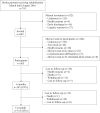Societal burden of stroke rehabilitation: Costs and health outcomes after admission to stroke rehabilitation
- PMID: 33856036
- PMCID: PMC8814873
- DOI: 10.2340/16501977-2829
Societal burden of stroke rehabilitation: Costs and health outcomes after admission to stroke rehabilitation
Abstract
Objective: To estimate societal costs and changes in health-related quality of life in stroke patients, up to one year after start of medical specialist rehabilitation.
Design: Observational.
Patients: Consecutive patients who received medical specialist rehabilitation in the Stroke Cohort Outcomes of REhabilitation (SCORE) study.
Methods: Participants completed questionnaires on health-related quality of life (EuroQol EQ-5D-3L), absenteeism, out-of-pocket costs and healthcare use at start and end of rehabilitation and 6 and 12 months after start. Clinical characteristics and rehabilitation costs were extracted from the medical and financial records, respectively.
Results: From 2014 to 2016 a total of 313 stroke patients completed the study. Mean age was 59 (standard deviation (SD) 12) years, 185 (59%) were male, and 244 (78%) inpatients. Mean costs for inpatient and outpatient rehabilitation were US$70,601 and US$27,473, respectively. For inpatients, utility (an expression of quality of life) increased significantly between baseline and 6 months (EQ-5D-3L 0.66-0.73, p = 0.01; visual analogue scale 0.77-0.82, p < 0.001) and between baseline and 12 months (visual analogue scale 0.77-0.81, p < 0.001).
Conclusion: One-year societal costs from after the start of rehabilitation in stroke patients were considerable. Future research should also include costs prior to rehabilitation. For inpatients, health-related quality of life, expressed in terms of utility, improved significantly over time.
Keywords: cost analysis; health-related quality of life; rehabilitation; stroke; utility.
Conflict of interest statement
Figures


References
-
- Truelsen T, Piechowski-Jóźwiak B, Bonita R, Mathers C, Bogousslavsky J, Boysen G. Stroke incidence and prevalence in Europe: a review of available data. Eur J Neurol 2006; 13: 581–598. - PubMed
-
- Langhorne P, Coupar F, Pollock A. Motor recovery after stroke: a systematic review. Lancet Neurol 2009; 8: 741–754. - PubMed
-
- van Rijsbergen MW, Mark RE, de Kort PL, Sitskoorn MM. Subjective cognitive complaints after stroke: a systematic review. J Stroke Cerebrovasc Dis 2014; 23: 408–420. - PubMed
-
- Lazar RM, Boehme AK. Aphasia as a predictor of stroke outcome. Curr Neurol Neurosci Rep 2017; 17: 83. - PubMed
-
- Carod-Artal J, Egido JA, González JL, Varela de Seijas E. Quality of life among stroke survivors evaluated 1 year after stroke: experience of a stroke unit. Stroke 2000; 31: 2995–3000. - PubMed
MeSH terms
LinkOut - more resources
Full Text Sources
Other Literature Sources
Medical

